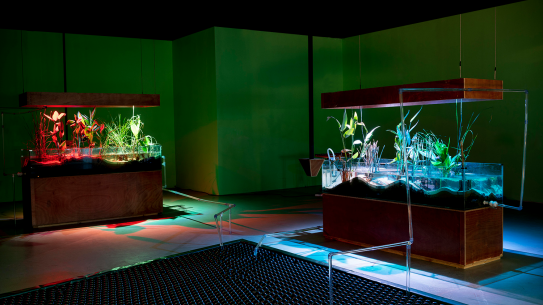Professor’s Work Explores Intersection of AI and the Environment
Tega Brain’s latest installation uses AI to modify mini-ecosystems

Tega Brain's Deep Swamp features aquarium tanks filled with wetland species, and whose climate is repeatedly modified by an artificial intelligence agent.
Can artificial intelligence (AI) help researchers, engineers, and conservationists solve our current environmental challenges? This is the question on the minds of many as major companies like Microsoft launch initiatives like AI for Earth and seek out ways to use AI to help environments sustain themselves autonomously.
It’s also a question that NYU Tandon Professor Tega Brain has been wrestling with in her latest project, Deep Swamp. An art installation that finds itself at the intersection of engineering, urban design, ecology, and machine learning, Deep Swamp features aquarium tanks filled with wetland species and three AI agents named Harrison, Hans, and Nicholas who modify their environments to attempt to attain an “ideal” wetland.
Trained on massive collections of image data culled from the web, each of the AI agents has a distinct goal. Harrison works towards shaping its ecosystem that looks like a ‘natural’ wetland. Hans mimics landscape paintings to produce a wetland environment similar to artistic representations of nature. Nicholas seeks out attention, and optimizes its environment to try to attract visitors.
“Each system takes a photo every few minutes, looks as the photo and asks, ‘How close is it to becoming a natural wetland, or to becoming a work of art, or attracting the attention of gallery goers?’” Brain, an assistant industry professor in Integrated Digital Media, explains. “Each system will reinforce the conditions that score the highest in this process, and then tries to optimize its environment based on these settings.”

Deep Swamp debuted at the Chronus Art Center in Shanghai, China in July 2018 as part of the “Machines Are Not Alone: A Machinic Trilogy” exhibition. Playing with the exhibit’s theme of “machinic ecology,” Brain’s installation grapples with the role of AI and machine learning in trying to sustain ecosystems without human intervention. Expressive of her research and work that she deems “eccentric engineering,” Brain hopes her project prompts visitors to consider the complexity of trying to control our environment. “How ecological problems are framed, and therefore what gets engineered as appropriate ‘solutions’ are thorny questions that go way beyond the technical.”
“Wetlands are now seen as a technology, and we often build them to purify water, to reduce flooding, and improve water quality downstream, but historically we haven’t preserved them. They’re places we’ve built airports and parking lots.” Brain explains, who said her past work in building wetlands for urban stormwater treatment inspired her decision to experiment with these ecosystems. “Our understanding of the environment is only partial, yet we continually work with the assumption that we’re able to model, manage, and therefore optimize the environment in certain ways.”
Deep Swamp reveals a tendency that Brain sees to view nature as a machine, a view that is reinforced by our culture’s celebration of computational technologies. “We see the environment as data, a model, a thing to manipulate and engineer, but this is just one way to look and engage with it,” Brain shares, noting the environment’s continual resistance to being fully represented in a technological system.
The exhibit and the Deep Swamp installation will be on view at the Chronus Art Center through October 21, 2018. Brain will also be taking Deep Swamp on tour, as it will be featured in the 6th Guangzhou Triennial in December 2018 at the Guangdong Museum of Art, China.



